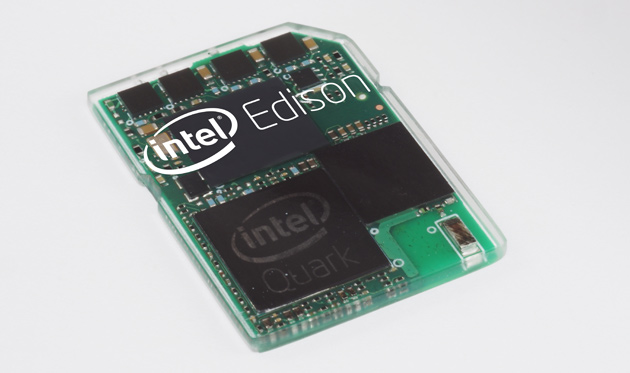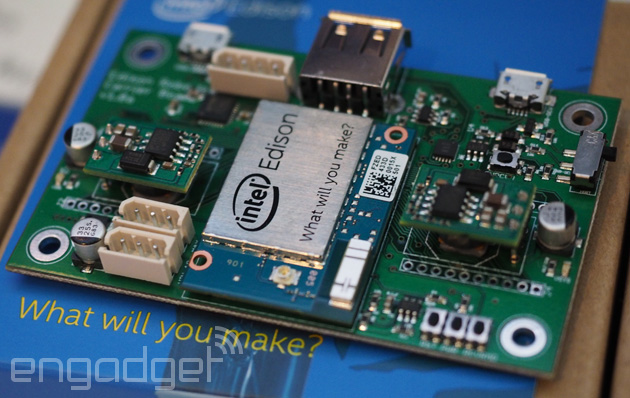Thinking about using Intel Edison for your next builder project, but feeling a little uninspired? Don't worry: IDF 2014 is rife with examples of how to use the company's new development board. In the weeks leading up to the conference, Intel employees and partners alike used it to build robots, memes, high-altitude balloons and even clothing for a small showcase of the development board's potential. Care for a peek? Check out the gallery below to see some of Engadget's favorite Edison projects from IDF 2014.
Showing posts with label Intel. Show all posts
Showing posts with label Intel. Show all posts
Thursday, 11 September 2014
Here are seven cool projects made possible with Intel's tiny computer
Thinking about using Intel Edison for your next builder project, but feeling a little uninspired? Don't worry: IDF 2014 is rife with examples of how to use the company's new development board. In the weeks leading up to the conference, Intel employees and partners alike used it to build robots, memes, high-altitude balloons and even clothing for a small showcase of the development board's potential. Care for a peek? Check out the gallery below to see some of Engadget's favorite Edison projects from IDF 2014.
Sunday, 15 June 2014
Intel stuck with $1.45 billion fine in Europe for unfair and damaging practices against AMD

For years, Intel has quietly fought a battle to dodge the EU’s ruling that it abused its dominant market position and damaged AMD. Today, it lost that fight. The EU has affirmed that the case was properly decided in 2009, and that the fine of 1.06 billion euros (around $1.45 billion) was proportionate. This fine is in addition to the $1.25 billion settlement that Intel ponied up in 2009 following an FTC investigation in the US.
The EU’s second-highest court states: “The General Court considers that none of the arguments raised by Intel supports the conclusion that the fine imposed is disproportionate. On the contrary, it must be considered that that fine is appropriate in the light of the facts of the case.”
Intel, obviously, disagrees and has strenuously argued the contrary — but a review of the 542-page EU findings of fact in the case make that argument untenable.
The EU found, in part:
- That Intel paid rebates to manufacturers on the condition that they would buy all (Dell) or nearly all of their CPUs from Intel.
- That it paid retail stores rebates to only stock x86 parts.
- That it paid computer manufacturers to halt or delay the launch of AMD hardware, including Dell, Acer, Lenovo, and NEC.
- That it restricted sales of AMD CPUs based on business segment and market. OEMs were given permission to sell higher percentages of AMD desktop chips, but were required to buy up to 95% of business processors from Intel. At least one manufacturer was forbidden to sell AMD notebook chips at all.
 Intel then further restricted manufacturer sales by only allowing the 5% of business systems to be sold to small and medium enterprises, only via direct distribution, and only if the business distributor pushed back the launch a further six months.
Intel then further restricted manufacturer sales by only allowing the 5% of business systems to be sold to small and medium enterprises, only via direct distribution, and only if the business distributor pushed back the launch a further six months.
Reuters has a further point-by-point list of the various findings.
The difference between “aggressive competition” and “antitrust abuse”
One of the differences between the EU and US judicial systems is that in the US, AMD would have had to prove that consumers were directly harmed by Intel’s actions. In the EU, consumer harm is not required to prove market abuse — simply that a company abused its dominant position and distorted the competitive market. Given the scope and scale of Intel’s actions, it’d be difficult to argue that this didn’t happen.
Intel ramped up these behaviors in the early 2000s when the Pentium 3 had run out of gas and the P4 was floundering. It began leaning on them even more aggressively once Opteron and the Athlon 64 launched — Intel executives are on-record as referring to Dell as “the best friend money can buy.” Elsewhere, Intel openly acknowledges that it used rebates (also called the MCP, Meet Comp Program) to keep OEMs away from AMD.
At one point, a Dell executive notes that Intel executives “are prepared for an all-out war if Dell joins the AMD exodus. We get ZERO MCP for at least one quarter while Intel ‘investigates the details’ … We’ll also have to bite and scratch to hold 50%, including a commitment to NOT ship in Corporate. If we go in Opti, they cut it to <20% and use the added MCP to compete against us.” (Opti meaning Optiplex, Dell’s business segment). Note that Intel isn’t just threatening to withhold payment — it’s telling Dell it’ll take the MCP money the company would’ve gotten, and give it to Dell’s competitors.
In the past, I’ve gone after OEM manufacturers for failing to take any kind of risks in product marketing and creating an abominable laptop market, but there is another side to this particular coin. Intel’s own policies created and enforced a situation in which OEMs were ultimately trapped in a cutthroat race-to-the-bottom scenario — if Dell gave up marketingfunds, HP could take those funds, cut its prices lower to compensate, and then be undercutting Dell. In its original antitrust filing, AMD noted that it tried to give HP a millionfree processors at one point, only to be told that HP was so dependent on Intel rebates, it couldn’t afford to take them.
The table below shows Dell’s MCP payment receipts from Intel according to SEC filings. The FTC conducted its own investigation as well.
Note that beginning in 2005, when AMD launched dual-core Athlon 64 processors and was seriously hammering Prescott, Intel’s payments sharply increased.
A winning strategy
It’s hard to ignore the fact that in the long run, Intel got exactly what it wanted. AMD certainly deserves blame for its own mistakes — overpaying by 2x for ATI was a colossal blunder — but Intel still systemically disenfranchised its primary competitor from gaining market share. Whether this was bad for consumers depends on whether you think the Pentium D (Prescott) and dual-core Smithfield were bad components. From my perspective as a CPU reviewer, these were the nadir of Intel’s competitive position, and yes — AMD’s Athlon 64 and Opteron hardware deserved a better shot than it got.
Intel’s $1.25 billion payout to AMD in 2009 probably fairly represents the profit AMD might have taken home over the same intervening period, but this was never about profits — it was about time. And no matter what Intel ended up paying to the EU, it won time from AMD — and AMD was forced to spin off GlobalFoundries in an attempt to accelerate its own product roadmaps.
Of course, in the long run, one might argue that Intel’s myopic focus on stuffing AMD and dominating the PC channel blinded it to the threat that was coming up behind. Today, Santa Clara dominates its conventional markets, but continues to struggle to break into new ones. That’s cold comfort for AMD, but it neatly illustrates how even an industry-dominating titan can be caught unawares by events outside its direct control.
Monday, 31 March 2014
Intel's SD card-sized computer may not be so tiny after all

Back at CES, Intel made a big deal of the fact that it could squeeze a Linux-based PC with Bluetooth and WiFi into the size and shape of an SD card. However, with just a few months to go before the launch of these miniscule Edison development boards, it looks like the chip-maker has changed tack. Instead of being based on the Quark SoC, which was specifically designed for wearables and the Internet of Things, the first Edison products will actually rely on a more traditional Atom chip -- in other words, the same sort used in many current Windows tablets and hybrids. An Edison PC based on Atom should deliver more grunt and connectivity options compared to Quark, and for less money, but it'd be too chubby to ever get accidentally jammed in an SD slot. That's why Intel has been forced to admit that, while it continues to work on Quark, the Edison devices coming this summer will be "slightly larger" than was first claimed.
Subscribe to:
Posts (Atom)


